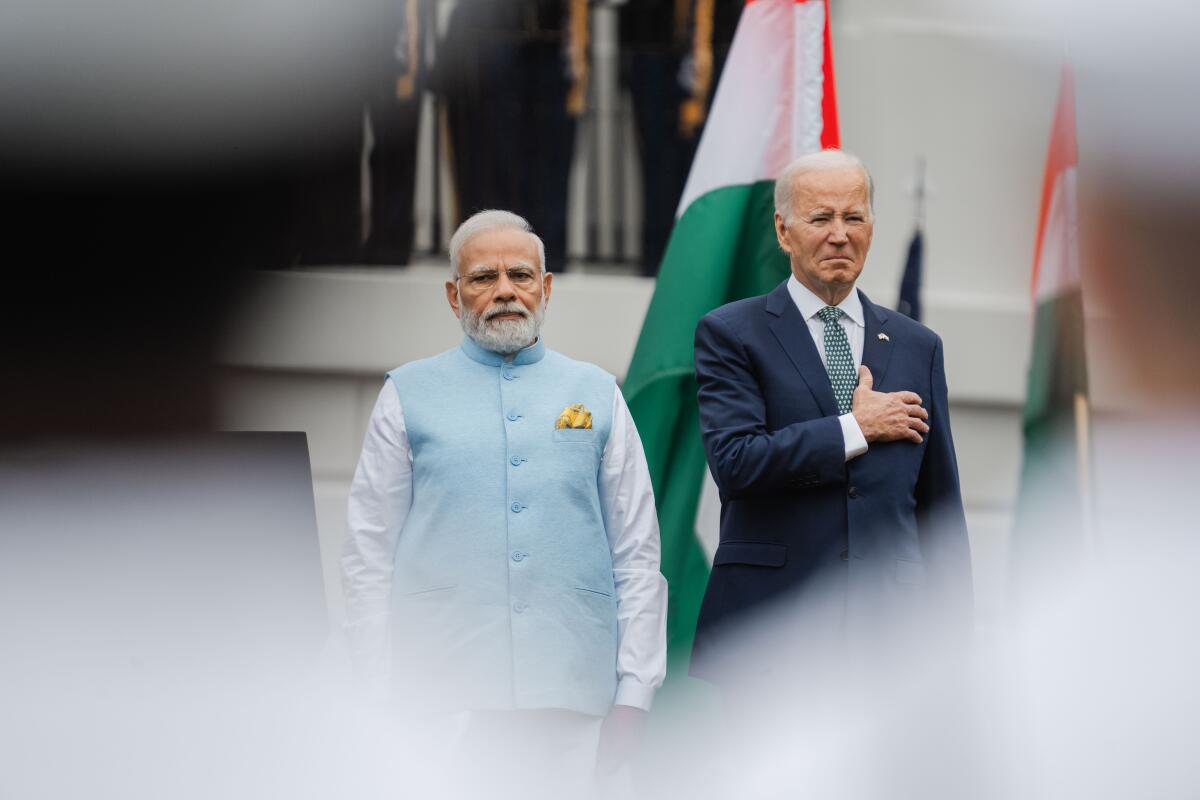India hopes to lead on climate, but coal still powers its economic growth

- Share via
NEW DELHI — Indian Prime Minister Narendra Modi hopes to use the Group of 20 summit, which kicks off Saturday in New Delhi, to urge other leaders to step up their clean energy transition.
Modi, who has overseen a rapid expansion of India’s renewable energy industry, has set bold targets to power more of the country with solar, hydrogen and biofuels over the next decade. He’s pledged that half of India’s energy will come from renewables by 2030, and is pushing other countries to triple global renewable energy capacity by that year.
But Modi’s own country remains overwhelmingly reliant on coal. India, the world’s third-largest carbon emitter, is expected to increase its coal fleet by 25% by 2030, adding nearly 56 gigawatts of coal power capacity. Coal still accounts for about 70% of India’s energy needs.
The contradiction is one of several that have undercut India’s efforts to lead on climate change ahead of the summit, which brings together the leaders of the world’s largest economies.
Modi wants the richest G-20 members, such as the U.S. and the European Union, to commit to reducing fossil-fuel use. But India — and other members such as China and Saudi Arabia — are reluctant to make the same commitment.
“India is not going to compromise its energy needs by committing to cut coal usage, particularly because its average per-person emissions are apparently among the lowest in the world,” said Manjari Chatterjee Miller, a senior fellow for India, Pakistan and South Asia at the Council on Foreign Relations.
India, the world’s most populous country, accounts for about 7% of global emissions. But it emits far less than most other countries on a per capita basis, with 1.93 metric tons of carbon dioxide per person.
The G-20 countries could make a huge dent in global emissions if they agreed to cooperate. Together, the G-20 accounts for two-thirds of the world’s population, 85% of the world’s gross domestic product and around 80% of planet-warming emissions. But when G-20 climate and environment ministers met in Chennai, India, in July, they failed to agree on a joint statement about climate change. The ministers splintered on transitioning to clean energy, peaking emissions by 2025 and imposing a carbon tax to help cut emissions.
“If we can’t make progress at the G-20 and can’t push them along, then it is really problematic,” a senior Biden administration official told The Times, adding that Washington hoped to make “incremental progress at minimum” on climate while the countries’ leaders were in New Delhi.
“In the past, the G-20 has been a useful forum because you have most of the major emitters there in the room, the major economies in the room, for clearing through some of these issues and setting the foundation for an agreement,” said Michael Froman, a U.S. trade representative in the Obama administration.
“In this case, it appears that not only are the traditional parties that stand against issues like that — like Saudi Arabia and Russia— but actually China’s now being more explicit in its opposition to discipline on fossil fuels as well,” he said.
The outcome of the G-20 climate talks could set the stage for the annual United Nations climate change conference, which will be held in the United Arab Emirates in November, Froman added.
During the 2021 U.N. climate talks, India joined China in a last-minute objection to weaken a pledge to phase out coal.
India would have to scale up renewable capacity at least three times its current pace in order to meet Modi’s 2030 pledge, according to Sumant Sinha, chief executive of ReNew, India’s largest renewable company.
“Even if we move at this massive pace ... we will just be barely touching the new demand that we will be generating,” Sinha said. “To do any more than that — it’s going to be difficult. ... We’d have to compromise on our economic growth, which as you know, no country in the world wants to compromise on.”
Modi has good reason to push other countries to embrace a green transition and wean off fossil fuels. India is among the countries most at risk from climate change, according to the U.N.’s Intergovernmental Panel on Climate Change.
India has a history of grappling with extreme heat, and the South Asian nation has continued to break heat records, most recently in July, which was the hottest month on record globally. In June, a blistering heat wave in Uttar Pradesh left more than 100 dead.
Researchers have warned that by 2050 more than 90% of India could face extreme heat that exceeds “the survivability limit for a healthy human resting in the shade,” according to a University of Cambridge study released in April.
Climate change also poses a threat to India’s economy. Extreme heat is straining public health, agriculture and other sectors, the study found.
Modi and other developing-world leaders have expressed hopes that richer, Western nations will help them finance their transitions to renewable energy. But the tricky politics of such aid means that little has been forthcoming. In 2021, President Biden pledged $11.4 billion annually in U.S. climate aid for developing nations, but a Republican-controlled House has dimmed any chance of unlocking that money.
Now Washington is pitching reforms for the World Bank and other multilateral development banks to help low- and middle-income countries access climate financing. U.S. officials have described the effort as an alternative to China’s Belt and Road Initiative, which invested billions in developing countries but left many in debt.
In August, the White House asked Congress for $3.3 billion in new funding to boost the World Bank’s lending power. The administration has also asked for authorization for a loan of up to $21 billion to the International Monetary Fund. The proposals could unlock more than $200 billion in new financing for developing countries, administration officials say.
Though the White House still needs Congress to sign off on its plan, the U.S. hopes to secure commitments from allies and other partners to help foot the bill, Treasury Secretary Janet L. Yellen told reporters in New Delhi on Friday.
Biden has had much more success advancing his domestic climate agenda. Last year, he signed a sweeping climate and drug-pricing bill that included roughly $370 billion to transition the U.S. to clean energy.
India will pave its own way on expanding renewables, U.S. Ambassador to India Eric Garcetti said.
India’s rapid expansion of renewables will eventually outpace even the U.S., predicted the former L.A. mayor, who said he’s met with Indian energy officials.
“By the end of this decade, Los Angeles will be 97% carbon-free, but I think India’s transition will be quicker than L.A.,” he said. “Small things that come from a country as big as India are equal to the size of many midsize countries doing big things.”
Subramanian reported from New Delhi. Wilkinson reported from Washington.
More to Read
Sign up for Essential California
The most important California stories and recommendations in your inbox every morning.
You may occasionally receive promotional content from the Los Angeles Times.












